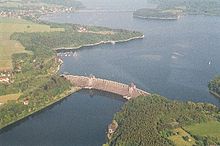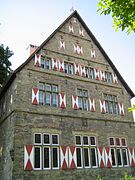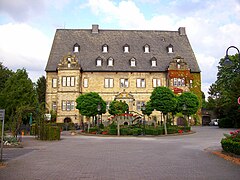

The Hellwegbörden lie in North Rhine-Westphalia. They extend on both sides of the eponymous Hellweg, an old trade route.
Regions
.jpg/220px-Soester_Börde_zwischen_Schwefe_und_Borgeln_(5).jpg)
The Hellwegbörden belong to the Westphalian lowland bay, so they are the southern continuation of the Münsterland in transition to Sauerland and Ruhr area.
In terms of nature, the Hellwegbörden become part of the Oberbörden (south of Hellweg) and the Suburbs (north of Hellweg) structured. Historically and socially, however, other classifications are common, the most famous of which is the central one Soest Börde. In the south of the Hellwegbörden lies the Strand of hair, a range of hills up to 391 meters high. Politically, the Hellwegbörden largely belong to the districts of Soest and Unna as well as the independent city of Hamm.
places


- 1 Lippstadt
 , historical town in the Geseker Börde
, historical town in the Geseker Börde - 2 Soest
 , historical city with a well-preserved medieval old town; Europe's largest old town fair in November
, historical city with a well-preserved medieval old town; Europe's largest old town fair in November - 3 Bad Sassendorf
 was officially recognized as a moor and brine spa in 1975. The spa gardens, thermal baths and graduation tower were redesigned.
was officially recognized as a moor and brine spa in 1975. The spa gardens, thermal baths and graduation tower were redesigned. - 4 Anröchte
- 5 Ense
- Erwitte
- Geseke
- Lippetal
- Ruethen
- Salzkotten
- Werl
- Wickede (Ruhr)
The following places naturally belong to the Hellwegbörden, but are also counted as part of the Ruhr area:
Also Büren and Paderborn is still part of the Hellwegbörden natural area, but is above all the more politically defined region Ostwestfalen-Lippe assigned.
Other goals

- The Möhne reservoir with the Möhnesee is at the transition from Soester Börde to the Sauerland. The dam is an interesting technical structure and has historical significance because of the "Möhne disaster", a flood disaster triggered by the bombing of the dam, which cost the lives of over 1000 people (most of them foreign prisoners of war). Above all, however, the area around the reservoir is a popular recreational area.
background
language
getting there
- The closest airports are Paderborn-Lippstadt (PAD) and Dortmund (DTM). However, there are more connections on Dusseldorf Airport.
- ICE stop is Hamm (Line Berlin – Hanover – Cologne). An ICE from Nuremberg or Frankfurt (Main) also stops once a day in Soest, Lippstadt and Paderborn. Intercitys (Düsseldorf – Kassel – Erfurt line, three times a day) also stop in Soest, Lippstadt and Paderborn. Otherwise, the RE 1 (Aachen – Cologne – Düsseldorf – Essen – Paderborn) and the Münster – Hamm – Paderborn (–Altenbeken) and Dortmund – Soest regional trains run every half hour to or through the Börden.
- The most important road axis in the region is the A 44 Dortmund – Kassel motorway. The northern edge of the Börden can also be reached on the A 2 (Hanover – Dortmund), and its western part on the A 1 (Bremen – Dortmund – Cologne). The Hellwegbörden can be reached from the Sauerland via the A 45 or A 46 / A 445. The classic way of traveling is to use the B 1 federal road (Dortmund – Unna – Soest – Paderborn), the course of which corresponds to that of the historic Hellweg.
- The BahnRadRoute Hellweg-Weser leads from Hamelin above Bad Pyrmont and Bielefeld to Soest. On the Roman Lippe Route one arrives from Xanten or Detmold in the northern part of Hellwegbörden (Hamm, Lippstadt). Route R 6 leads from Lower Rhine (Goch, Hamminkeln) and the Hohen Mark (Haltern) as well as the Eggegebirge, the R 43 from Osnabrück here.
mobility
Most of the Hellwegbörden are part of the Ruhr-Lippe Transport Community. So it applies Ruhr-Lippe tariff. The most important cities in the region can be reached every half hour on the regional train lines Hamm – Paderborn or Dortmund – Soest. Other places (e.g. Erwitte, Lippetal, Möhnesee, Rüthen, Wickede) can be reached from Lippstadt, Soest or Werl with buses from the RLG (Regional traffic Ruhr-Lippe).
There are numerous signposted cycle paths in the region, for example the Hellweg route (Unna – Werl – Soest – Erwitte – Geseke – Paderborn), the R 43 cycle path (Lippetal – Soest – Möhnesee), the Auenland cycle path (Welver-Vellinghausen – Lippetal– Lippstadt), the Hellweg-Radio-Bäderroute (Bad Sassendorf – Lippstadt – Erwitte – Bad Sassendorf).
Tourist Attractions
- Soest:
- Historical old city with several culturally and historically significant churches from Romanesque to Gothic, remains of the medieval city fortifications, the baroque town hall and numerous half-timbered buildings.
- Burghofmuseum - Patrician house from the 16th century with a knight's hall and Romanesque house from around 1200, the city's oldest surviving residential building.
- Werl:
- Provost church of St. Walburga, Gothic hall church made of local green sandstone (14th century).
- Pilgrimage Basilica of the Visitation of the Virgin Mary, neo-Gothic from the early 20th century, with a carved miraculous image of the Virgin Mary with baby Jesus from the 12th century. Next to it the smaller, baroque one old pilgrimage church.
- House Assen - Moated castle in the Lipperenaissance style near Lippetal-Lippborg
- Hovestadt Castle - Moated castle in the style of the Lippe Renaissance near Lippetal-Herzfeld
- Unna: Hellweg Museum

St. Patrkli Cathedral Soest

Soest Castle Courtyard Museum

Central nave, St. Walburga Werl
Pilgrimage Basilica Werl
.jpg/271px-20140601_131316_Haus_Assen,_Lippetal_(DSC02281).jpg)
House Assen

Hovestadt Castle
- Erwitte:
- Erwitte Castle - Renaissance moated castle
- Parish Church of St. Laurentius - Romanesque from the 9th century with a high tower
- Geseke: former Collegiate Church of St. Cyriakus
- Lippstadt:
- Great St. Mary's Church
- Cappel pen - Originally a Romanesque Premonstratensian monastery, later converted into a Protestant women's monastery.
- Overhagen Castle - Moated castle in the style of the Lippe Renaissance, partly extended in baroque style
- Schwarzenraben Castle - Baroque moated castle at Lippstadt-Bökenförde

Erwitte Castle
Leaded glass window in the Laurentiuskirche Erwitte

St. Cyriakus Geseke
Great Marienkirche Lippstadt
Cappel Collegiate Church

Schwarzenraben Castle
activities
- Cycling on numerous signposted routes
- City Theater Lippstadt
Soest is in a state of emergency during the week of All Saints' Day. The entire old town will be converted into a fairground and the city of less than 50,000 inhabitants welcomes one million guests to Europe's largest old town fair within a week.









.JPG/240px-Bas.Werl_fd_(3).JPG)
.jpg/271px-20140601_131316_Haus_Assen,_Lippetal_(DSC02281).jpg)






